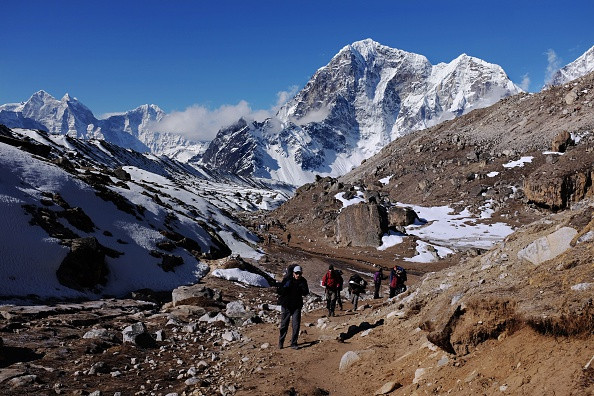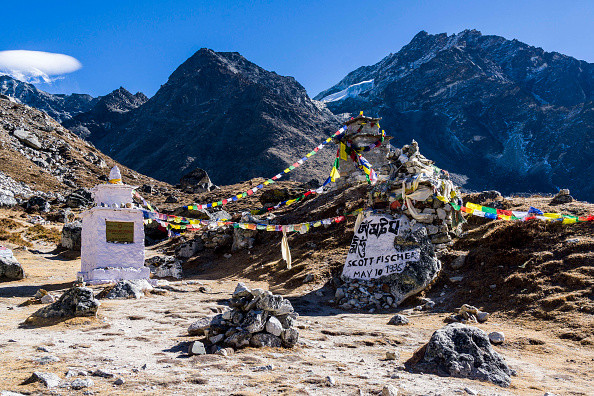Everest deaths: What is mountain sickness and what happens to your body at high altitudes?

A Indian man has become the third person to die in three days while attempting to climb Mount Everest. The Earth's highest mountain, Everest reaches up to 8848 metres – over 29,000ft
Following this string of tragedies, questions have been asked about what could be done to better insure the safety of climbers.
The three people who died in the past few days had been suffering from acute altitude sickness. Their bodies struggle to adapt to low supplies of oxygen at high altitudes.
IBTimes UK look at how the condition manifests, and what happens to the body high up in the mountain?
What is altitude sickness?
Altitude sickness, known as mountain sickness, is caused by a combination of two factors: the measure of elevation and how fast people climb up. It is estimated that nearly a quarter of people who go above 7,000 to 9,000 feet will develop acute mountain sickness, and that proportion will reach 42% above 10,000 feet.
The severity of symptoms vary from minor headaches and dizziness, to acute illness with fluid accumulation in the brains and lungs which can be fatal. Typically, people will experience a throbbing and painful sensation in their head, near the temple region. This will generally come with fatigue, dizziness, nausea and lack of appetite and sleep.
If left untreated, the condition can evolve into "acute mountain sickness" and lead to cerebral edema. Victims will experience confusion, loss of coordination, disorientation and altered conciousness. Within a day, the swelling in the brain can cause them to slip into a coma and eventually die if they don't receive urgent care.
Additionally, some climbers may suffer from high-altitude pulmonary edema (HAPE). It develops more frequently in young, fit men when they go over 8,000ft. Beyond altitude and rhythm of ascent, cold temperatures are an additional risk factor here, as they increase pulmonary artery pressures.
Early symptoms include fatigue, lower exercise performance, difficulties breathing during the climb and dry coughs, but since all of these are not very specific, they can be hard to detect. When someone has trouble breathing while resting and audible chest congestion, it suggests he suffers from HAPE and his condition is deteriorating.

Avoiding acute mountain sickness
Prevention and rapid treatment are key to avoiding these dramatic scenarios. Measures can be undertaken to make sure people avoid falling sick in the first place; the most important being a gradual ascent to acclimatise to lower oxygen levels which can be done by taking a day of rest at moderate altitude, between 5,000 and 6,000ft. Another recommendation is that people who reach 8,000ft should avoid climbing up more than 2,000ft daily after that.
As altitude sickness is directly linked to a lack of oxygen, treatment should focus on increasing oxygen levels. This includes staying at the same altitude until the body gets better acclimatised, or descending in altitude if symptoms persist. If this is not possible, providing supplemental oxygen and different drugs against symptoms, such as ibuprofen for headaches, becomes necessary.
What happens to the body?
Decreased oxygen can have a devastating effect on the body and it explains the symptoms people can display. When the body lacks of oxygen, signalling molecules are released causing a dilatation of blood vessels in the brain and an increased permeability of the blood-brain barrier.
This allows the body to keep delivering oxygen to the brain, however, it also increases cerebral blood pressure. In addition, kidneys begin retaining water. All of this leads to brain swelling, which can become very severe in some people and lead to edema.
Pulmonary edemas are also linked to decreased oxygenation, which induces an important increase in pulmonary artery pressure. This often happens as a result of uneven constriction of pulmonary blood vessels, in some people.
Less tightened vessels get damaged, leading to leakage and increased pulmonary blood pressure. If such pressure remains high, the lung vessels weaken and eventually rupture. This causes the lungs to swell, and is responsible for breathing difficulties in HAPE victims, eventually leading to their deaths.
© Copyright IBTimes 2025. All rights reserved.






















